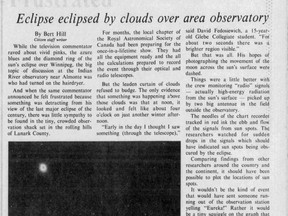“The leaden curtain of clouds refused to budge,” then Ottawa Citizen reporter Bert Hill wrote of the eclipse, which he watched from an observatory near Almonte.

Article content
The last time a total solar eclipse blotted out the sun over Ottawa, on Feb. 26, 1979, sky watchers walked away from the scene less than awestruck.
The rare astronomical spectacle was itself blotted out by the low, grey cloud common to Ottawa winters.
Article content
“The leaden curtain of clouds refused to budge,” then Ottawa Citizen reporter Bert Hill wrote of the eclipse, which he watched from an observatory near Almonte. “The only evidence that something was happening above those clouds was, at noon, it looked and felt like about four o’clock on just another winter afternoon.”
Advertisement 2
Story continues below
Article content
Glebe Collegiate student David Fedosiewich had been hoping to photograph the historic moment when the moon passed between the Earth and sun, throwing shade on a swath of the planet. He brought a telescope to watch the event.
“Early in the day, I thought I saw something,” he told the newspaper. “For about two seconds, there was a brighter region visible.”

The event was billed as the final solar eclipse of the 20th century in North America, and it was accompanied by much of the same fanfare that now surrounds April 8th, when a total solar eclipse is to cast parts of daytime Canada into darkness for a few minutes.
In 1979, the path of totality – the part of the Earth fully shaded by the moon – was about 300 kilometres wide.
Brandon, Manitoba was in the middle of that zone, which meant it would be in near darkness for three minutes. That made it a destination for eclipse chasers from across the continent.
The skies were clear over much of Manitoba when the moon started its journey across the face of the sun on the morning of Feb. 26, 1979.
Ottawa Citizen columnist Charles Gordon was in Brandon to record the scene. In his column, published the following day, he called the eclipse a “dress rehearsal for the end of the world.”
Advertisement 3
Story continues below
Article content

Gordon, now 83, said in an interview that the event lived up to the hype, even if the people of Brandon were more interested in the Canada Winter Games, which they were then hosting. He remembers the most dramatic moment as the beginning of the eclipse: when a sliver of moon first darkened one touch of the sun.
“It really did live up to the hype,” said Gordon, who was appointed to the Order of Canada last year. “I remember it getting it really dark and really cold – mind you it was Brandon in February – but I remember it getting colder. It was really quite spooky.”

Toronto Star feature writer Ross Howard was in Brandon, too, to describe the event for readers. “The morning sun turned a deep velvet blue, a final spear of yellow light flashed from a sliver of sun. Then it was gone,” he wrote. “A ring of diamonds spun round the rim of the moon…and then there was just a deep gray hole in the sky, surrounded by a boiling, silver halo.”
The CBC hosted a national television special from Winnipeg, where the eclipse cast the city in enough darkness to trigger its automated streetlights. Many drivers turned on their headlights. Schoolchildren were kept indoors for fear they would damage their eyes by looking at the spectacle.
Advertisement 4
Story continues below
Article content
The period of totality began at 10:47 a.m. and lasted for two minutes and 16 seconds in Winnipeg.
This year, a number of cities in Ontario, including Niagara Falls, Kingston and Cornwall, lie in the path of totality.
Ottawa will experience a partial solar eclipse.
But if the past is any guide in this city, viewers should be prepared for disappointment.
On July 10, 1972, a total eclipse was visible across much of northern Canada, but in Ottawa, clouds and a summer haze prevented people from fully appreciating it.
On July 20, 1963, another total eclipse could be seen across a swath of the country, but again, viewers in Ottawa were frustrated by the city’s full cloud cover.
Charles Gordon said he doesn’t have plans to seek out Monday’s solar eclipse.
“I think one is enough,” he said.

Recommended from Editorial
Our website is your destination for up-to-the-minute news, so make sure to bookmark our homepage and sign up for our newsletters so we can keep you informed.
Article content


Comments